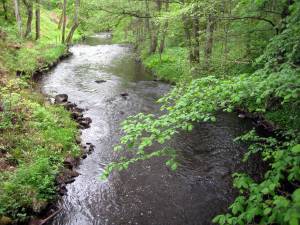When I was a child, my favourite moments were those spent at my grandmother’s cabin. It was an ugly pea-soup green, the kind of colour that must have been purchased on sale. The roof was thin, the nail-tips visible from below. Not surprisingly, this cabin had poor insulation: enough so to justify sleeping an extra hour until the temperature warmed, even in the summer. When my cousins and I woke, there was a fire in the fireplace, and my grandmother ready for a card game, in which we waged bets with broken bits of liquorice. In a similar pattern of mismatched extremes, the carpet was bright fire-red and not large enough to protect the creaky floor below. It didn’t matter. Such things didn’t detract, or perhaps added to, its charm.
My grandmother, Mormor, was the essence of this place and remains one of the most important persons who touched my life. She was soft and kind and spoke with a gentle accent; as much a part of her as anything else. And while she was benevolent to all, she lived for her grandchildren. Maybe that was what made the ugly green cabin, on the edge of the forest, so special.
The woods behind the cabin was a magical place for any child. When I was 8, we were allowed to venture there, alone. I was the oldest and self-appointed authority, taking advantage to organize all rules by which any fantasy was properly conducted. My sister and cousins usually tired of my bossy leadership and I was soon left alone: to set up, or take down, what was left of our humble forest home.
For a few summers we used the same place. The soft moss carpet below our naked feet grew warn; as we accustomed our home to the way the towering trees had fallen. Peaking through, the sun hit our patch and cast the warmest glow on any and all of our random activities. There were no electronics to curb our thoughts. My cousins painted videogames on rocks, although they couldn’t advance past level 1, and soon tired of this.
For hours we sat, doing everything and nothing. Old tree stumps became tables for dinner parties and were clothed in the most ragged table-clothes granted to us. We were free, happy and covered in mosquito bites. But that didn’t matter, because everything in those moments belonged to us.
…
Years later, I remember the old tablecloth we placed on the tree stumps in the forest. It was given to us because it was too ugly to be displayed inside, but even now I remember its beauty. I miss its touch, its outdated pattern and the hole I used to run my fingers through. I miss that place; it was as much a part of me as anything; even though it may be difficult to put a price on rotten wood, trampled moss or mosquito bites.
Such lessons taught us to appreciate the bigger things by first bestowing respect for the less significant ones: to appreciate creaky floors because a home was full; to earn a fractured piece of liquorice; to value siblings, cousins and spaces for imagination. It was in those moments, in which I gained a respect and reverence for the mystery and awe of life: the natural world and human relations.
Many seasons have since passed: the moss carpet probably re-grown; new trees reach to the skies and the path re-routed. My beloved grandmother has passed away and while we continue to miss her, she lives on: in the lazy days of childhood; a part of the scents, sounds, and places of our imaginations and our laughter.
I touch fondly my Grandmother’s old necklace – and feel her. I remember the old tree stumps, probably rotted away, where my sister and I entertained the most prestigious imaginary guests and the chipped porcelain we used to serve them. And to such broken things, mismatched extremes and childhood memories, I now reflect:
• to carpets worn thin by too many children’s feet trampling their central tracks;
• to old shoes worn by our parents when they were young;
• to forest paths we cut ourselves;
• to backyard compost piles which smell foul, but teach the natural cycle;
• to hard work and sweat that teach you to earn your respect and rank;
• to humility which teaches you that you can’t hold on to it for too long;
• to dusty corners hiding memories we will not know we appreciate, until we realize someone else can;
• to uncompromised and unrestrained imaginations;
• to broken and mismatched plates that remain from meals and persons past;
• to those who build our foundations, depicting their lives as models of patience, persistence, convictions, simple pleasures and sacrifice;
• to all things and all dusty corners, that have no (economic) value but the value they have in themselves, for ourselves …

